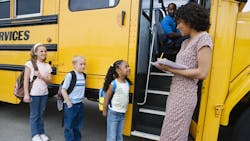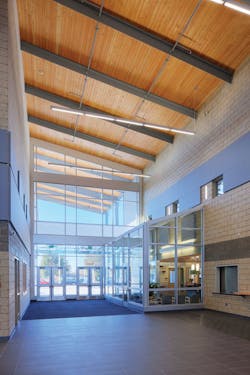Facility managers play a crucial role in ensuring the safety of education institutions, whether it’s mitigating the risks of threats from suspicious individuals or potentially dangerous packages left on school grounds.
In collaboration with community efforts, facility managers can determine how to best address the various risks within their schools.
Facilities and Equipment
Restricting access is an important element of security. Evaluate the points of access to school grounds, and consider perimeter barriers such as fencing that make access easier to monitor. Schools also should work to eliminate potential hiding places for intruders, such as large, untrimmed bushes, and ensure that plenty of lighting is installed around the grounds to discourage illicit activities.
Within a building, doors play a pivotal role in protection. Wherever possible, install heavy-duty doors using glass reinforced with wire mesh. This will make classroom and office access more difficult for intruders. In addition, all doors should be able to be locked from the inside.
If the budget permits, install locks that can be activated automatically from the school office. First-aid kits should be available in every room and checked regularly to replace used or expired supplies.
Install exterior doors that are strong enough to deter forced entry. Automatic locking features may help school personnel stop suspicious visitors from entering a building.
The average emergency response time is 18 minutes, and a school shooting incident lasts an average of only 12 minutes, so every minute a hostile party is kept outside and away from classrooms could save lives. In addition to locking interior doors, consider installing closed-circuit cameras at strategic points outside and inside the building. They act as a deterrent, provide real-time information, and serve as a valuable source of forensic evidence after an incident.
An intercom system always should connect classrooms with the central office. In addition, two-way radios can be used to communicate throughout a school if normal communication channels have been interrupted. These should be kept in classrooms and other school areas; battery power and functionality should be tested regularly as a part of routine emergency procedure reviews.
Schools should prepare floor plans and building schematics that can be shared with emergency responders. They also should keep digital files on hand that can be sent to the authorities. Copies of escape routes should be posted throughout a school facility to aid evacuations. A school should have at least two main evacuation routes that are posted in conspicuous places. Staff and students should undergo regular drills and follow these evacuation routes.
In addition to formal measures designed to restrict access to schools, several campus design tactics promote improved security. Crime Prevention Through Environmental Design (CPTED) strategies such as intelligent landscaping, lighting and fencing all play a part in safety. Other important guidelines to consider have been established by the American Society for Industrial Security (ASIS) and the International Association for Professional Security Consultants (IAPSC).
A survey of high-school students found that one in 20 students reported carrying a weapon onto school grounds at least once within the month preceding the survey. And 7.4 percent of students say they had been threatened or injured with a weapon on the school property once or more in the past year. These data underscore the importance of establishing effective school security processes and procedures.
Personnel and Training
Every school employee must undergo a background check before employment. This will include a criminal history, substance-abuse issues, as well as their employment experience. Employees should undergo drug testing, fingerprinting and also have a photo ID taken. To reduce the time spent by employees conducting these checks, an education institution may ask potential employees to use outside background check providers.
Internally, education institutions should hire or train a staff safety officer who will be responsible for developing and carrying out of an emergency response plan. In addition, this person will coordinate all security-related activities for a school—performing drills, or keeping the staff updated on new security processes.
In addition, schools should regularly assign a staff member, on a rotating basis, to patrol and visually inspect the school grounds and to deter suspicious activity or identify possible emergencies. This staff member should carry a radio to contact the office if trouble is spotted. The security inspection should follow varied routes and take place at varying times, to avoid any predictability.
Training school staff is as important as having the right equipment. The facility manager should participate actively in school safety plans and have a say in training procedures. Develop standardized procedures so all employees—including facility technicians—know their part in whatever emergency arises. This training is far more likely to be effective if regular drills are performed. A few moments spent remembering procedures can potentially save lives.
Devise a standard procedure for any school visitors. Specify who should be required to check in at the office and issued a temporary visitor badge, for example. Individuals without such a badge will be easy to identify by staff, who can alert school administrators. This policy may be altered as needed for vendors, who could be issued permanent security badges after undergoing background checks. Schools also may want to consider hiring a professional security officer to deal with potential dangers. This may even be a member of local law enforcement, assigned to the school as a resource officer. This helps develop a positive relationship among students and law enforcement.
Communication Improvement
Communication is critical in an emergency. Schools should create a committee of staff members, including the facility manager, to develop a communications plan. The plan should include the mobile phone numbers for all staff members, and establish procedures for emergencies that require evacuation, as well as those requiring sheltering in classrooms.
Staff members should be notified that nature of the crisis that is occurring. The committee will establish appropriate communication protocols for emergencies, such as intercom broadcasts, two-way radios or text. This committee also will be responsible for coordinating communication efforts with law enforcement and the community in general.
Cader is branch manager for ABM Security Services in northern California. He also works as a part-time police officer for the state of California, as well as an adviser to a homeland security contractor in bioterrorism and emergency notifications.

